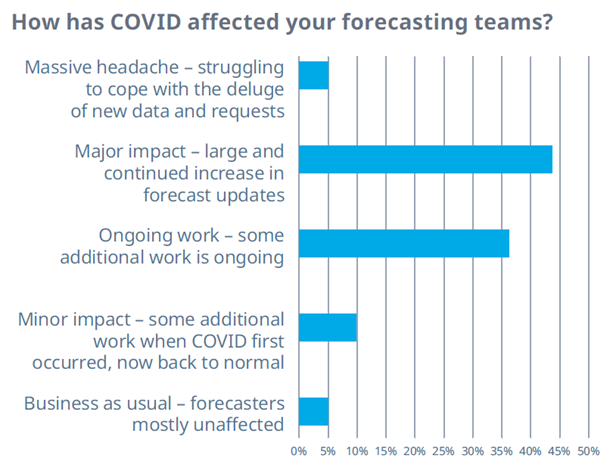





















- Blogs
- Lessons from the Pandemic for Commercial Forecasting Teams
The pharmaceutical industry has rarely seen the level of volatility, uncertainty, complexity and ambiguity (VUCA) that caused by the COVID-19 pandemic. The result has been an evolution of forecasting tools and techniques, as conventional forecasting methods struggled to account for such dramatic events.
Forecasting is about predicting future events based on past results. When a marketplace is stable, these methods are the cornerstone of the planning process. But the sweeping VUCA created by the pandemic and other market events made it impossible for pharma forecasters to predict future outcomes due to a lack of historical data to inform them.

At an IQVIA event in Sep 2020, about six months into the pandemic, almost half1 of industry professionals surveyed said COVID has had at least a major impact on their forecasting teams, and five percent called it “a massive headache” and said they are struggling to cope with the deluge of new data and requests.
Instead of lamenting the shortcomings of an outdated process, the pandemic should be seen as a wakeup call for forecasters that they need to identify ways to deliver faster, more accurate results - especially in times of rapid change.
Because while the pandemic is an extreme example of VUCA, disruptive events happen all the time in this market. Entrance of new competitors, release of trial results, a changing political environment around reimbursement, and the release of game changing therapeutic innovations make slow-to-update forecasts increasingly irrelevant and introduce new kinds of risk to the forecasting process.
As Donald Rumsfeld famously said: “There are known knowns — there are things we know we know. We also know there are known unknowns — that is to say, we know there are some things we do not know. But there are also unknown unknowns, the ones we don’t know we don’t know.” These ‘unknown unknowns’ — like the unexpected COVID-19 pandemic — can sometimes carry great risk, and forecasters have to figure out how to manage them when they appear.
To do this, we’re proposing a set of changes to the forecast process that are focused around driving down the time it takes to re-forecast when a change occurs.
Radically Simplifying the Forecast Process
Imagine being able to make significant changes to a commercial forecast and communicate those changes to senior leadership in three minutes or less. That is the type of responsiveness executives would hope for from a forecast in times of volatility. And it’s possible — when forecasters make two significant changes to their process.
- Bring external data into the model. In times of large-scale market change, key inputs may be fluctuating on a monthly, weekly or even daily basis. To track these trends, forecasters need to introduce global external data sources that provide enough perspective to stay abreast of changing trends and to inform inputs in the forecast structure. Being able to automatically incorporate that data without massive effort and seeing the impact of trends more quickly is critical to managing VUCA.
- Replace offline models and spreadsheets with online forecasting systems. Typically, to get data from a data source into the forecast it needs to be collected, often manually transcribed, and then transformed through filtering, calculations, and other formatting. Executing these steps manually can take days - delaying access to the forecast and making it extremely difficult to update or modify data in response to specific questions or changing trends.
Next generation forecasting platforms automate all of these steps so that the latest internal and external data can be instantly pulled into the forecast, trended, and mapped to specific inputs. This allows forecasters to include much larger and more complex data from more sources, and to quickly generate insights from the latest information for timely action.
The combination of external data and advanced technology transforms the forecast from a static document that can be rendered rapidly obsolete in volatile times, to a powerful predictive tool that adapts with the market.
For example, these new platforms enable another trend that is vital to forecasting in a crisis – cross-department collaboration. To generate the most accurate and up-to-date information, forecasters may need to coordinate cross-functionally with supply chain, marketing, finance and regulatory professionals, who will determine which data sets are required to understand how the crisis will affect the product and what they can do to mitigate risks and maximize results.
With conventional forecasting methods, gathering this data takes weeks of back and forth. With advanced forecasting platforms, stakeholder groups can link their own data directly to the platform and update it as needed, eliminating the need for forecast teams to track it down and streamlining the process significantly.
No Time to Waste
The COVID-19 crisis exposed critical weaknesses in commercial forecasting processes and has challenged forecasters to be more adaptive. In times of rapid change, forecasters need to align the cadence of their analysis and reporting to the level of disruption in the marketplace and the urgency of action required by the company. To do that, they can’t waste time on the mechanics of updating the forecast - they need to be able to get straight to the insights.
When forecasters transform their processes to recognize and react to changing trends, they become the ‘first responders,’ able to inform leaders about how unexpected events impact future plans.
Contact us at ForecastHorizon@iqvia.com for information about the Forecast Horizon platform and better managing VUCA!
1 September 2020 Client-facing, IQVIA sponsored webinar “Commercial Forecasting in a Time of Rapid Change”





